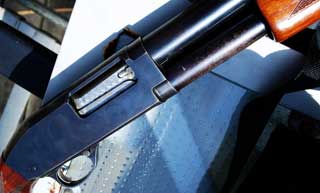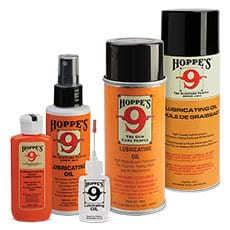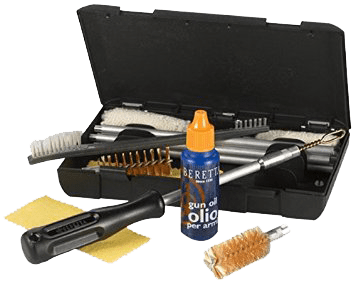
The topic of gun cleaning is one met quite often with a variety of opinions. There are some who swear by never cleaning their weapon, holding to the thought that it makes their trusty shotgun that much luckier and pays homage to successful past usage. There are others who clean their gun after every use.
How often you clean your gun will likely come down to personal preference and how often you use it. But as for how to clean a shotgun, we’ve got you covered.
There are a lot of benefits to regularly cleaning your gun. With regular cleaning, you have the opportunity to inspect your gun thoroughly and will know when something isn’t right. This allows you to correct matters or to take your shotgun to a gunsmith for repair with plenty of time left before hunting season.
Regular cleaning of your gun also helps increase its life expectancy and provides you with consistent performance – both of which can be crucial if you rely upon your shotgun as your go-to weapon while living in the bush or on a remote homestead.
Getting Started on Cleaning Your Gun
1. Check and double-check if the gun is unloaded
Before you do anything, make sure the gun is unloaded and double-check that it’s unloaded. Check one more time just to be sure. This procedure may seem excessive, but considering how frequently an “unloaded” gun has gone off while cleaning it becomes apparent that too many people forget this step. Safety first, people. Now, check to make sure your weapon is unloaded one final time.
When it comes to cleaning any gun, whether it’s a pistol, semi-automatic rifle, or a single shot 12-gauge shotgun, the procedures can be summed up in two steps: cleaning and lubricating.
In cleaning, you’ll be working on removing any field debris that may be left from your last excursion in the wilderness, powder fouling, and old lubricant. All of these things can impact the performance of your gun, and old oil can collect dust and grime, forming an abrasive substance that damages the steel of your shotgun.
2. Work in a well-ventilated area
To start, you’ll want to be in a well-ventilated area. That means if you’re working in your garage, be sure to open the door to allow for proper ventilation of fumes from solvent spray cans. If indoors, you’ll want to open the windows and cover your workspace to prevent staining due to solvents and gun oil.
3. Prepare the cleaning kit
A universal shotgun cleaning kit will come with everything you need to clean your gun effectively. It should have a three-part cleaning rod (necessary for cleaning out the barrel of your gun), a brass bore brush, an attachment end for the cleaning rod, a nylon cleaning brush, microfiber cleaning cloths, cleaning solvent, and lubricant.
You may also want to have a few rags on hand to wipe up spills and to thoroughly dry your shotgun when you’ve finished.
Make sure you have the right type of solvents for the kind of gun you have as certain chemicals can damage synthetic stocks. Keep the gun oil off of the wood stock and fore-end. This oil is meant for metal, not wood, and can damage the wood. If you want to clean the wood, then try a spray-on furniture polish or a protective wax designed specifically to protect the wood.
Disassembling your Gun
Before we go any further, check to make sure the gun is unloaded. Even if you’ve already checked and double-checked, check one more time to be sure that the gun is unloaded before proceeding to the next step. You don’t need to take those kinds of chances, and it’s better to be safe than sorry.
Keep in mind that this is very likely the step where you stand the greatest chance of screwing up big time. It’s incredibly important that you don’t disassemble your gun any further than the manufacturer recommends and not any further than you feel comfortable.

Unless if you have a lot of experience with the gun you’re working with, or extensive levels of training with the disassembly and reassembly of that gun, it is highly advised that you not disassemble the action.
Just picture your workspace covered in small springs and then having to put each one back where it was exactly the same way. For the inexperienced, this is a situation that should rightfully fill you with dread.
Remember: Guns are different and just because you know how to disassemble and clean one type of gun doesn’t mean you can easily reassemble another gun.
It’s also important to remember that different shotguns require varying levels of cleaning, with some even requiring differing types of oil in the action or none at all. Before cleaning any gun for the first time, be sure to consult the owner’s manual and follow the manufacturer’s instructions.
To get started, remove the barrel (if possible) and the gas chamber (if it has one). For some shotguns, like a single-shot 12 gauge, you may not be able to do anything more than open the chamber the same as you would when loading it; this is fine.
Cleaning the Barrel
Inspect the gun to see how much cleaning will be required. You’ll be able to see any accumulated gunk build-up on the barrel threads and accumulation of powder fouling which will be dull in color when dry but will turn shiny when wet with cleaning solvent or lubricant.

To clean the barrel, you’ll need the three-part cleaning rod, the attachment end, the brass bore brush, and four cleaning pads.
Cleaning the Choke
Not all shotguns have a removable choke; some have it integrated with the muzzle of the gun and additional cleaning (outside of cleaning the barrel) isn’t necessary.
If the choke is removable on your shotgun, unscrewing it will allow you to clean it better; however, you also risk damaging the threads on the barrel of the gun by screwing the choke back in wrongly.

General recommended cleaning methods involve soaking the choke for a prolonged period, but you can get it thoroughly clean by spraying some solvent into the choke and using the brass brush to scrub all the gunk out. The combination of the solvent blast and the brass brush is enough to break up any gunk in there.
If you do unscrew the choke, you’ll need to clean out the threads on the end of the barrel. A few blasts of cleaning solvent and your trusty brass brush will be able to get the job done quickly. Then take an old rag and twist it into the barrel to clean out the threads. A dab of oil is enough to lubricate the choke to reinstall it and prevent seizing.
Cleaning the Action
How much cleaning the action needs and what it needs to be cleaned with can differ greatly with different types of shotguns. Some shotguns you really can’t do much more than wet the end of a cotton swab with solvent and wipe down the action as best you can. Other guns, you shouldn’t clean the action at all, while some require just a bit of lubrication with Teflon oil.

Don’t risk your gun by guessing at what the proper procedure is. Consult the manufacturer’s instructions on how far you should disassemble the action, how much cleaning you should do, and with what you should clean the action.
Lubrication Tips
In general, apply oil anywhere metal touches metal such as the hinges, trunnions, ejectors, where the barrel joins the receiver, locking lug (deep inside the receiver), and the fore-end lock.

Any gun oil that gets onto the wood stock or fore-end should be wiped off immediately in order to not damage the wood. Wipe off any excess lubricant as it can collect dust and debris which is abrasive to the steel of your gun and can cause damage.
Finishing Up
Once you’ve wiped off any excess gun oil, it’s time to reassemble your gun. Do so carefully and in reverse order from how you disassembled it. Now bring the weapon to your shoulder to be sure that everything looks and feels right. Be sure to wipe off all moisture before storing your gun to protect it against rust.

Now that you know how to clean a shotgun, as always, be sure to store your gun in a child-safe location, keeping it unloaded with ammunition in another location where small hands also can’t access it. While this is a very basic way to clean your shotgun, this simple procedure will help keep your gun in good working order and help it to perform well for many years to come.
For a general use shotgun used fairly often, it makes sense to clean your gun every once in a while to make sure you have a reliable weapon on hand. If this is a gun that is used just for that annual hunting season, then it is recommended to clean it before and after the season.


